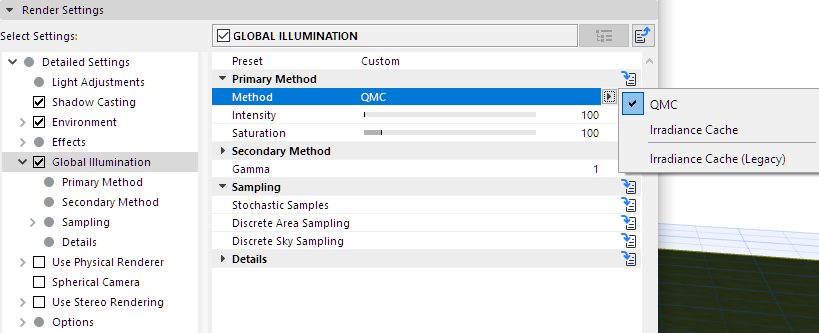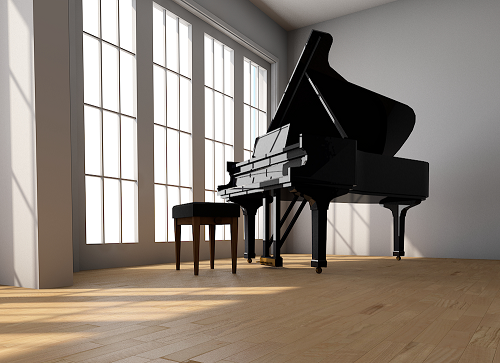
Primary and Secondary Method (CineRender Global Illumination)
GI in CineRender works in two parts:
•The Primary Method calculates the effect of Diffuse Depth 1, which is
–the light emitted by polygon lights
–or the light emitted by illuminated surfaces (via real light sources or the Physical Sky) without further reflection. The latter case results in the typical GI lighting with indirect reflection of light (e.g. a red sphere illuminated by a white light reflects red light).
•The Secondary Method calculates the brightness of surfaces (that do not have to lie in the camera’s field of view) that are brightened by multiple light reflections.

Primary Method only brightens surfaces that are directly lit.
Secondary Method is responsible for additionally reflected light.
In this example, only the Primary Method was used on the left picture. Both Primary and Secondary methods were used on the right picture.
In each picture, the left uses a polygon light, the right uses a normal light:

The results of both methods will be added to make up the overall GI when rendered.
The Primary Method is most important method for the render quality and therefore higher-quality methods such as QMC or IR should be used. These also take correspondingly longer to render! For light that is reflected back-and-forth, methods can be used that are of “lesser quality” and render faster (such as Radiosity).
Depending on the project’s setup, different methods can then be combined. Use the predefined Presets.
See Preset (CineRender Global Illumination).
Tip: The two-part GI calculation already existed in previous versions: With Mode set to IR and Sampling set to Radiosity Maps, this corresponds to the current Irradiance Cache Primary Method and Radiosity Maps Secondary Method.
In the following you will find a brief description of the individual methods.

•Quasi-Monte Carlo (QMC): QMC is the most precise but slowest method. Animations are flicker-free (if not free of noise) when QMC+QMC is used.
For details, see How Does QMC Work?
•Irradiance Cache: A simplified, fast method of ascertaining the most important areas of a given project, calculating GI at these locations, and interpolating. Animations tend to flicker if the values are too low.
For details, see Irradiance Cache.
•Irradiance Cache (Legacy): This is the Irradiance Cache from CineRender versions prior to V20. It has been maintained so older Projects can be rendered with the same render results.
For details, see Irradiance Cache (Legacy) (CineRender Global Illumination).
Options for Secondary Method

•Quasi-Monte Carlo (QMC): QMC as a Secondary Method is best when used as IR+QMC for exterior scenes, and most precise - and slowest - as QMC+QMC.
•Irradiance Cache: IC as Secondary Method works well for interior spaces with small lights defined as Portal or Polygon lights. Make sure to reduce the Samples value in combination with QMC+IR. Internally, a much greater number of QMC samples is used for IR, which can increase render times very dramatically.
•Radiosity Maps: Radiosity Maps as Secondary Method are well-suited for fast preview renderings because of their low Diffuse Depth (less reflected light).
For details, see Radiosity Maps.
•Light Mapping: Light Mapping as Secondary Method works very well when rendering interior spaces where a lot of light is needed, which can be very quickly supplied by the high number of light reflections from Light Mapping.
For details, see Light Mapping.
•None: Disables the secondary GI calculation. This represents a Diffuse Depth of 1.
Intensity (Primary and Secondary)
Use these parameters to adjust the GI brightness based on the number of light reflections. The Primary Intensity parameter affects the regions being illuminated directly; the Secondary Illumination parameter affects reflected light.

From left to right, the following Primary/Secondary Intensity values:
100%/100%, 300%/100%, 100%/500%
Saturation
Defines the color saturation used within the GI calculation separately for the Primary and Secondary Method GI functions. This is especially useful if the Physical Sky produces shadows that are too blue. Try reducing the Saturation value for the Secondary Method.
If other methods produce too little saturation (as is sometimes the case with IR/QMC as a secondary method), the Saturation value can be increased.
Note that if the Primary Method’s Saturation setting is set to 0%, no colors will be available for the Secondary Method.

A single blue Polygon Light lights the scenery, with various Saturation settings.
Note how the Secondary Method at the center emits colorless light.
For Radiosity Maps, the Secondary Method’s Saturation will only affect real Area lights (not Polygon Lights) and/or Physical Sky (which is given a real light source via the Sun light).
Color saturations can also be modified for surfaces (see also Illumination (CineRender Surface Channel)). Both saturation parameters represent a global, project-wide saturation setting.
Of the many GI-related parameters, the Diffuse Depth value (which can be defined only for the Irradiance Cache or QMC Secondary Methods) can make a significant difference in rendering quality. It defines the number of times light reflects in a scene, i.e. how often a “ray of light” is reflected from surfaces.
Greater Diffuse Depth values will result in moderately longer render times (the difference between a value of 1and 2 is greater than that between 2 and 8) but the dispersion of light will become increasingly homogeneous, brighter and more realistic. However, the effect at values greater than 3 in a normal scene will become less and less noticeable and the rendered result will simply become brighter.
•The minimum Diffuse Depth value of 1 (as in the following image) results in only a direct illumination via flat, light-emitting elements. This will be sufficient for most external scenes, with Physical Sky or HDRI Sky providing a significant light source.

•A Diffuse Depth value of 3 (as in the following image) is required to achieve an indirect illumination, i.e. light reflected from other surfaces. A minimum value of 2 will be required for interior scenes.

Note that gamma correction can, within limits, be used to compensate for lower Diffuse Depth values.
Tip: When “real” light sources are used, indirect illumination can already be achieved with a Diffuse Depth value of 1 because the objects illuminated by the light source will be recognized as a luminous object.
Gamma
This gamma value only affects the indirect GI lighting. Gamma values define how the internally rendered brightness values should be displayed in RGB mode. Simply stated, a progression from the darkest (black) to brightest (white) is defined.
This lets relatively dark renderings (e.g. resulting from a low Diffuse Depth value) be brightened. But be careful - high gamma values will reduce contrast and “flatten” the overall image (values ranging from 1 to 3 have proven to be most effective; in some instances higher values may be necessary). Values less than 1 will darken the image, whereas values greater than 1 will brighten an image.
